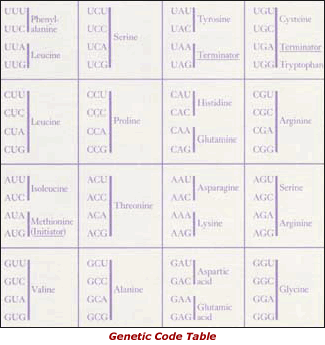Last updated: April 26, 2013
1966: Genetic Code Cracked
1966: Genetic Code Cracked
 Over the course of several years, Marshall Nirenberg, Har Khorana and Severo Ochoa and their colleagues elucidated the genetic code - showing how nucleic acids with their 4-letter alphabet determine the order of the 20 kinds of amino acids in proteins. Messenger RNA is interpreted three letters at a time; a set of three nucleotides forms a "codon" that encodes an amino acid. A three-letter word made of four possible letters can have 64 (4 x 4 x 4) permutations, which is more than enough to encode the 20 amino acids in living beings.
Over the course of several years, Marshall Nirenberg, Har Khorana and Severo Ochoa and their colleagues elucidated the genetic code - showing how nucleic acids with their 4-letter alphabet determine the order of the 20 kinds of amino acids in proteins. Messenger RNA is interpreted three letters at a time; a set of three nucleotides forms a "codon" that encodes an amino acid. A three-letter word made of four possible letters can have 64 (4 x 4 x 4) permutations, which is more than enough to encode the 20 amino acids in living beings.
In 1955, Ochoa isolated RNA polymerase, the enzyme that copies molecules of RNA from DNA. He made the first synthetic RNA molecules. Later, Nirenberg and Khorana took the lead in deciphering the genetic code. To an extract from E. coli, they added synthetic RNA and radioactively labeled amino acids and observed what kind of polypeptides were made. For example, poly-U RNA - an RNA string made completely of uracil - directed the formation of a phenylalanine chain, so the triplet UUU clearly encodes phenylalanine. This was the first codon deciphered. (Because of the redundancy of the genetic code, more than one codon can encode most amino acids; for example, the codon UUC also specifies phenylalanine.)
In time, all the codons were deciphered, including AUG, which not only encodes the amino acid methionine but is also required to start protein translation, and the three codons that signal the end of protein synthesis - the "stop codons" UAG, UAA, and UGA.
More Information
Khorana and Nirenberg, along with Robert Holley, won the 1968 Nobel Prize in Physiology or Medicine "for their interpretation of the genetic code and its function in protein synthesis."

« Previous Event | Next Event »
